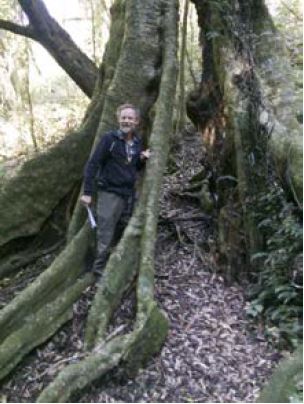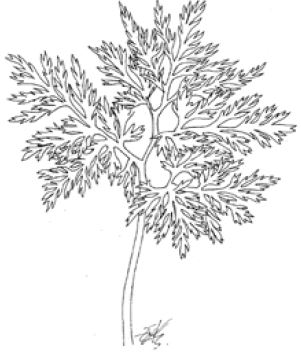Trip Report – 7 May 2016 : Warrens’ Bush, South Makara Road, Wellington
Our hosts, Janet and Mike Warren, welcomed us to botanise in their two contiguous QEII Open Space Covenants, and gave us a health and safety briefing. BotSoc first visited this impressive ‘primary forest’ remnant in 1994, following a recce by the leaders in 1991. Attracted by the combination of a little-known location, and fine weather, the turnout of thirty-three people was big for a day trip, and included nine on their first BotSoc field trip.
The covenants, which total 56ha, cover three main gullies and intervening spurs, ranging in elevation from c. 70m - c. 280m above sea level, near turbines on the West Wind windfarm. During the 19th-century Terawhiti gold-rush, the catchment was known as ‘Erin-go-Bragh Gully’, after the mine, with a 70-foot tunnel, near the head of the gully. The stream is a true right tributary of Karori Stream. The lower 16ha covenant was registered in 2005, the upper 40ha covenant in 2006. No one in the party has yet botanised in the upper covenant, so far as is known.
 |
Ian Goodwin inspects the buttresses of a senescent pukatea. |
References
1. Biological Resources of the Wellington Region. Jointly prepared by Wellington Regional Council, Queen Elizabeth II National Trust, NZ Biological Resources Centre. 1984. Site No. 10b: “One of the very few areas of (indigenous) forest in (the Wellington) southern peninsula”.
2. An Inventory of the Surviving Traces of the Primary Forest of Wellington City. Compiled for WCC by Geoff Park. 1999. Site No. O107.1: “Primary forest remnant”.
3. Terawhiti and the Goldfields. James Brodie. Karori Historical Society. 1986. Page 68 - map; pp. 88-89 - description of mining company & operations; page 325 - the gold mine is named ‘Erin Go Bragh’, (Ireland For Ever), 1869.
Leaving our fleet of cars in a barnyard, we crossed farm land to the forest edge. We were immediately impressed with the luxuriant growth of the liane, Metrosideros colensoi, near the creek, characteristically pendulous from its host trees. It was a new species for many members in the party, and made a useful teaching topic. It is much less common in Wellington ecosystems than M. diffusa and M. perforata.
Near where we entered the forest, we noticed that the eight-wire fence is in excellent condition. Inside the forest edge, we pushed through a dense, hiphigh, grove of young Piper excelsum subsp. excelsum, not present twenty years ago. This species, not palatable to browsing animals, protects the forest’s understorey from southerly gales, and provide a site for the seeds of several other species, including lianes, to germinate.
The forest includes one large rimu*, a hinau and several pukatea and rewarewa, each of great age and stature, emergent over a mosaic of regenerating, indigenous, broadleaved, semi-coastal forest species and adventive species. The hinau, in flower and fruit, was attracting numerous birds.
 |
Botrychium australe. Illustration: Eleanor Burton. |
We were delighted to see an extensive patch of parsley fern / Botrychium australe which is not common in Wellington’s native forests.
The paucity of Fuchsia excorticata, (only one seen), Coprosma grandifolia, C. lucida, (only one seen), C. robusta and Pseudopanax arboreus, all palatable to possums and goats, and all usually common in Wellington’s native forests, could be evidence of long-term browsing by pest animals.
As is typical of Wellington forest ecosystems, several of the emergent trees, mostly pukatea / Laurelia novae-zelandiae, appear senescent. Their eventual replacements are mostly still seedlings. Although pukatea seedlings are abundant, pukatea saplings and small pukatea trees, are uncommon. The reason why the sub-canopy tiers are muchreduced, and have very few pukatea saplings or young pukatea trees, is probably because they were eaten out before they could grow beyond the reach of browsing animals. In addition, saplings and small trees of other potentially-emergent species are not common. This phenomenon of ‘missing tiers’ is common in Wellington’s ‘primary forest remnants’.
The emergent rimu, on the True Right, which was sound in 2003, has fallen. We did not investigate the emergent rimu which is on the True Left, or see or record any rimu seedlings or saplings.
There are relatively few ‘nest epiphytes’, e.g., Astelia hastata and A. solandri, possibly because of damage by gales, browsing by possums, or seed-predation by rodents. We did not see swamp maire / Syzygium maire, recorded here in 1997 by Park (ibid). This species is not common in Wellington native forests.
We saw extensive evidence of pig-rooting on the true right slopes of the valley. We understand that pig-hunting occurs from time to time. We did not hear goats, or see any goat browse. We understand that goat hunting occurs from time to time. Twelve possum-bait stations have been mounted in the valley. Extensive possum-trapping, and follow-ups, are done - possum control is essential for the restoration of the natural functioning of this ecologically significant forest.
We saw some matai seedlings, c. 50cm tall, marked with flagging tape, on the valley floor. These were planted by Wellington City Council, on the advice of Trevor Thompson, QEII National Trust Regional Representative, who deemed this to be ‘an entirely appropriate supportive planting’.
All-in-all, a memorable day, thanks to the generosity of Janet and Mike Warren, and their foresight in covenanting their remarkable forest.
Participants : Mike Bartlett, Sam Buckley, Eleanor Burton, Gavin Dench, Katherine de Silva; Michele Dickson, Carolyn Dimattina, Jeremy Gallett-Walker, Ian Goodwin, Richard Grasse, Bryan Halliday, Michael Harrison, Stephen Hartley; Chris Hopkins, Chris Horne (co-leader / scribe), Rodney Lewington, Barbara Mitcalfe (co-leader / scribe), Chris Moore, Syd Moore, Richard Parfitt, Mick Parsons, Leon Perrie, Lynne Pomare, Mike Scrivens, Lara Shepherd, Mike Shepherd, Darea Sherratt, Karin Sievwright, Ianto Stevens, Sunita Singh, Julia Stace, John van den Hoeven, Sophie Williams.

 Site Index
Site Index







 Site Index
Site Index





